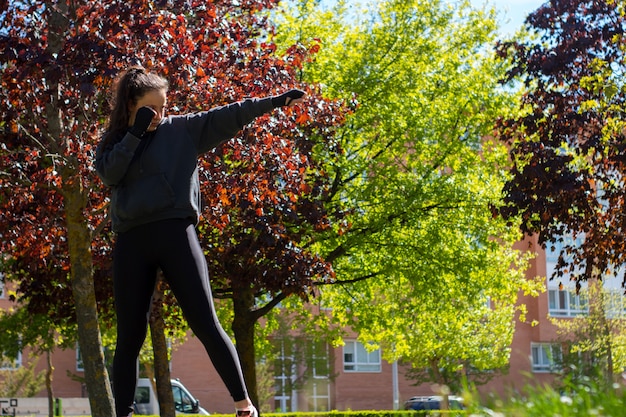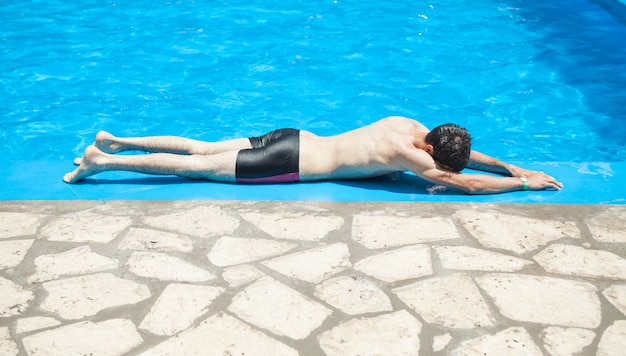Lower Blood Pressure Naturally: 3 Easy Home Exercises

Lower your blood pressure naturally through simple exercises you can do at home, such as brisk walking, cycling, and swimming, which promote cardiovascular health and reduce hypertension.
Want to **lower your blood pressure naturally** without medication? Discover three simple yet effective exercises you can easily incorporate into your daily routine at home to help manage hypertension and improve your overall health.
Understanding High Blood Pressure and the Need for Natural Solutions
High blood pressure, or hypertension, is a common condition that affects millions of people worldwide. It’s often called the “silent killer” because it typically has no symptoms, but it significantly increases the risk of heart disease, stroke, and kidney problems. While medication is often prescribed to manage high blood pressure, many individuals seek natural solutions as a complementary or alternative approach.
This search for natural remedies arises from a desire to minimize potential side effects associated with medications and to empower oneself in managing one’s health proactively. Regular exercise stands out as a powerful tool in this context, capable of producing significant improvements in blood pressure levels and overall cardiovascular health.
The Impact of Exercise on Blood Pressure
Exercise helps lower your blood pressure naturally by improving blood vessel function, reducing inflammation, and promoting a healthy weight. When you exercise, your heart pumps more blood, which over time can lead to a decrease in resting heart rate and blood pressure. Regular physical activity also helps the body use oxygen more efficiently, reducing the strain on the cardiovascular system.
- Improved Blood Vessel Function: Exercise helps to dilate blood vessels, making it easier for blood to flow through them.
- Reduced Inflammation: Regular physical activity can lower levels of inflammation throughout the body, which can contribute to hypertension.
- Healthy Weight Management: Exercise burns calories and helps to maintain a healthy weight, which is crucial for managing blood pressure.
Moreover, the psychological benefits of exercise should not be overlooked. Physical activity is a known stress reliever, and reducing stress can also contribute to lower your blood pressure naturally. Incorporating exercise into your daily routine can lead to a more balanced and healthier lifestyle.

Exercise 1: Brisk Walking – A Simple and Effective Start
Brisk walking is an excellent starting point for individuals looking to lower your blood pressure naturally. It is a low-impact exercise that nearly anyone can do, regardless of age or fitness level. All you need is a comfortable pair of shoes and a safe place to walk.
This accessible form of exercise works by increasing your heart rate and improving circulation. Over time, this can help to reduce the stiffness of your blood vessels, allowing blood to flow more freely and, accordingly, reducing your blood pressure.
Getting Started with Brisk Walking
To make brisk walking an effective part of your blood pressure management plan, consistency is key. Aim for at least 30 minutes of brisk walking most days of the week. If you are new to exercise, start with shorter intervals and gradually increase the duration and intensity as you get fitter.
- Warm-up: Begin with 5 minutes of slow walking to warm up your muscles.
- Pace: Walk at a pace where you can still hold a conversation but feel slightly out of breath.
- Cool-down: End with 5 minutes of slow walking and stretching.
Beyond the immediate physical benefits, brisk walking provides an opportunity to enjoy the outdoors, clear your mind, and reduce stress levels. Combining it with social interaction, by walking with a friend or family member, can further enhance the positive impact on your well-being.
Exercise 2: Cycling – Enjoyable Cardiovascular Workout
Cycling is a fantastic cardiovascular exercise that can help to lower your blood pressure naturally while being gentle on your joints. Whether you prefer cycling outdoors or using a stationary bike at home, the rhythmic pedaling engages large muscle groups, promoting healthy blood circulation and cardiovascular fitness.
Regular cycling can lead to a stronger heart, improved lung capacity, and a more efficient cardiovascular system. These benefits contribute to reducing your resting heart rate and blood pressure over time, making cycling an enjoyable and effective exercise for managing hypertension.
Cycling at Home or Outdoors
The versatility of cycling allows you to choose the environment that suits you best. Outdoor cycling provides the opportunity to explore nature, enjoy the fresh air, and vary your routes, while indoor cycling on a stationary bike offers a controlled and convenient workout, regardless of weather conditions.
- Outdoor Cycling: Enjoy scenic routes, but always prioritize safety by wearing a helmet and following traffic laws.
- Stationary Bike: Adjust the resistance to challenge yourself and track your progress using the built-in monitors.
- Duration: Aim for at least 30 minutes of cycling, several times a week, to reap the blood pressure-lowering benefits.
To maximize the benefits of cycling, focus on maintaining a consistent cadence and engaging your core muscles. Varying the intensity of your cycling workout with periods of high-intensity intervals can also enhance its effectiveness in lower your blood pressure naturally.

Exercise 3: Swimming – Full-Body Workout with Low Impact
Swimming is an excellent full-body exercise that is particularly beneficial for individuals with joint pain or mobility issues. The buoyancy of water reduces the stress on your joints, making swimming a comfortable and effective way to lower your blood pressure naturally.
Swimming works nearly all the muscles in your body, improving your cardiovascular fitness, muscle strength, and endurance. The rhythmic nature of swimming strokes promotes healthy blood circulation and reduces inflammation, contributing to lowering blood pressure over time.
Swimming Styles and Techniques
There are various swimming styles, such as freestyle, backstroke, breaststroke, and butterfly. Each style engages different muscle groups and offers unique benefits. Experiment with different strokes to find what you enjoy and what feels most comfortable for your body.
- Freestyle: A fast and efficient stroke that works your arms, legs, and core.
- Backstroke: A good option for individuals with back pain, as it strengthens the back muscles.
- Breaststroke: A slower stroke that emphasizes leg strength and coordination.
Regardless of the stroke you choose, focus on maintaining proper technique and breathing. Start with shorter intervals and gradually increase the duration and intensity of your swims as you get fitter. Aim for at least 30 minutes of swimming, several times a week, to lower your blood pressure naturally.
Integrating Exercise into Your Daily Routine
Incorporating these exercises into your daily routine is crucial for sustaining the benefits and achieving long-term blood pressure control. Start by setting realistic goals and gradually increase the duration and intensity of your workouts as your fitness level improves.
Consistency is key, so find activities that you enjoy and that fit into your lifestyle. Make exercise a regular habit, just like brushing your teeth or eating meals. Consider scheduling your workouts in advance and tracking your progress to stay motivated.
Tips for Staying Consistent
Staying consistent with your exercise routine requires planning, motivation, and self-discipline. Here are some tips to help you stick to your goals and make exercise a sustainable part of your lifestyle:
- Set Realistic Goals: Start small and gradually increase the duration and intensity of your workouts.
- Find Activities You Enjoy: Choose exercises that you find fun and engaging to increase the likelihood of sticking with them.
- Schedule Your Workouts: Treat exercise like any other important appointment and schedule it in your calendar.
- Track Your Progress: Monitor your blood pressure, heart rate, and fitness level to see how far you’ve come and stay motivated.
Remember, it’s okay to miss a day or two, but don’t let it derail your entire routine. Get back on track as soon as possible and keep moving forward.
Additional Lifestyle Changes to Support Lower Blood Pressure
While exercise is a powerful tool for lower your blood pressure naturally, it’s important to consider other lifestyle changes that can further enhance its effects. A healthy diet, stress management techniques, and adequate sleep are all crucial components of a holistic approach to hypertension management.
These lifestyle modifications work synergistically with exercise to create a comprehensive plan for achieving and maintaining healthy blood pressure levels. By addressing multiple factors that contribute to hypertension, you can maximize your chances of success and improve your overall well-being.
Dietary and Stress Management Tips
In addition to exercise, consider incorporating the following dietary and stress management tips into your daily routine:
- Reduce Sodium Intake: Limit your consumption of processed foods, which are often high in sodium.
- Increase Potassium Intake: Eat plenty of fruits and vegetables rich in potassium, such as bananas, sweet potatoes, and spinach.
- Manage Stress: Practice relaxation techniques, such as meditation, yoga, or deep breathing exercises.
- Get Enough Sleep: Aim for 7-8 hours of quality sleep each night to allow your body to recover and regulate blood pressure.
Consult with your healthcare provider or a registered dietitian to develop a personalized plan that meets your specific needs and goals. Remember, small changes can make a big difference in your blood pressure and overall health.
| Key Point | Brief Description |
|---|---|
| 🚶 Brisk Walking | Low-impact, improves circulation. Aim for 30 minutes most days. |
| 🚴 Cycling | Cardiovascular workout, gentle on joints. Indoor or outdoor options. |
| 🏊 Swimming | Full-body, low impact. Improves fitness and reduces joint stress. |
| 🥗 Diet | Reduce sodium, increase potassium. Consume more fruits and vegetables. |
Frequently Asked Questions (FAQs)
▼
Aim for at least 150 minutes of moderate-intensity exercise per week, or about 30 minutes most days of the week. Consistency is essential for sustained blood pressure control.
▼
Exercise can significantly lower your blood pressure naturally, but it’s often most effective when combined with other lifestyle changes, such as a healthy diet and stress management techniques.
▼
Stop exercising immediately and seek medical attention. Chest pain during exercise could be a sign of a serious underlying condition.
▼
Avoid high-intensity exercises that involve straining or holding your breath, such as heavy weightlifting. Consult with your doctor or a physical therapist for guidance.
▼
Some people may start to see improvements in their blood pressure within a few weeks of starting an exercise program, while others may take longer. Consistency and patience are key.
Conclusion
Incorporating brisk walking, cycling, and swimming into your daily routine can be a powerful way to **lower your blood pressure naturally** and improve your overall health. Remember to start slowly, listen to your body, and consult with your healthcare provider before beginning any new exercise program. With consistency and dedication, you can take control of your blood pressure and live a healthier, more active life.
